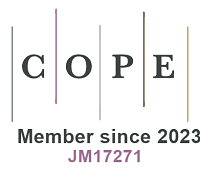REFERENCES
1. Dissanayake PD, Kim S, Sarkar B, et al. Effects of microplastics on the terrestrial environment: a critical review. Environ Res. 2022;209:112734.
2. Hale RC, Seeley ME, La Guardia MJ, Mai L, Zeng EY. A global perspective on microplastics. JGR Oceans. 2020;125:e2018JC014719.
3. Shen L, Worrell E. Chapter 31 - Plastic recycling. In: Handbook of recycling. Elsevier; 2024. pp. 497-510.
4. Alhazmi H, Almansour FH, Aldhafeeri Z. Plastic waste management: a review of existing life cycle assessment studies. Sustainability 2021;13:5340.
5. Haque F, Fan C. Fate of microplastics under the influence of climate change. iScience. 2023;26:107649.
6. McMullen K, Vargas FH, Calle P, Alavarado-Cadena O, Pakhomov EA, Alava JJ. Modelling microplastic bioaccumulation and biomagnification potential in the Galápagos penguin ecosystem using Ecopath and Ecosim (EwE) with Ecotracer. PLoS One. 2024;19:e0296788.
7. Matavos-Aramyan S. Addressing the microplastic crisis: a multifaceted approach to removal and regulation. Environm Adv. 2024;17:100579.
8. Li XF, Mitch WA. Drinking water disinfection byproducts (DBPs) and human health effects: multidisciplinary challenges and opportunities. Environ Sci Technol. 2018;52:1681-9.
9. Sutkar PR, Gadewar RD, Dhulap VP. Recent trends in degradation of microplastics in the environment: a state-of-the-art review. J Hazard Mater Adv. 2023;11:100343.
10. Pothiraj C, Amutha Gokul T, Ramesh Kumar K, et al. Vulnerability of microplastics on marine environment: a review. Ecol Indic. 2023;155:111058.
11. Ziani K, Ioniță-Mîndrican CB, Mititelu M, et al. Microplastics: a real global threat for environment and food safety: a state of the art review. Nutrients. 2023;15:617.
12. An L, Liu Q, Deng Y, Wu W, Gao Y, Ling W. Sources of microplastic in the environment. In: He D, Luo Y, editors. Microplastics in terrestrial environments. Cham: Springer International Publishing; 2020. pp. 143-59.
13. Singh A, Mishra BK. Microbeads in personal care products: an overlooked environmental concern. J Clean Prod. 2023;427:139082.
14. Anbumani S, Kakkar P. Ecotoxicological effects of microplastics on biota: a review. Environ Sci Pollut Res Int. 2018;25:14373-96.
15. Nabi I, Bacha A, Zhang L. A review on microplastics separation techniques from environmental media. J Clean Prod. 2022;337:130458.
16. Rillig MC. Microplastic in terrestrial ecosystems and the soil? Environ Sci Technol. 2012;46:6453-4.
17. Yang Y, Jalalah M, Alsareii SA, et al. Plastic wastes (PWs) and microplastics (MPs) formation: management, migration, and environmental impact. J Environ Chem Eng. 2024;12:112926.
19. Dube E, Okuthe GE. Plastics and micro/nano-plastics (MNPs) in the environment: occurrence, impact, and toxicity. Int J Environ Res Public Health. 2023;20:6667.
20. Wu P, Huang J, Zheng Y, et al. Environmental occurrences, fate, and impacts of microplastics. Ecotoxicol Environ Saf. 2019;184:109612.
21. Rossatto A, Arlindo MZF, de Morais MS, de Souza TD, Ogrodowski CS. Microplastics in aquatic systems: a review of occurrence, monitoring and potential environmental risks. Environ Adv. 2023;13:100396.
22. Wright SL, Thompson RC, Galloway TS. The physical impacts of microplastics on marine organisms: a review. Environ Pollut. 2013;178:483-92.
23. Canniff PM, Hoang TC. Microplastic ingestion by daphnia magna and its enhancement on algal growth. Sci Total Environ. 2018;633:500-7.
24. Rillig MC, Ziersch L, Hempel S. Microplastic transport in soil by earthworms. Sci Rep. 2017;7:1362.
25. Huang Y, Liu Q, Jia W, Yan C, Wang J. Agricultural plastic mulching as a source of microplastics in the terrestrial environment. Environ Pollut. 2020;260:114096.
26. Kumar M, Xiong X, He M, et al. Microplastics as pollutants in agricultural soils. Environ Pollut. 2020;265:114980.
27. de Souza Machado AA, Kloas W, Zarfl C, Hempel S, Rillig MC. Microplastics as an emerging threat to terrestrial ecosystems. Glob Chang Biol. 2018;24:1405-16.
28. Dad FP, Khan WU, Kirkham MB, Bolan N, Tanveer M. Microplastics: a review of their impacts on different life forms and their removal methods. Environ Sci Pollut Res Int. 2023;30:86632-55.
29. Oliveira M, Almeida M, Miguel I. A micro(nano)plastic boomerang tale: a never ending story? TrAC Trend Anal Chem. 2019;112:196-200.
30. Chen G, Feng Q, Wang J. Mini-review of microplastics in the atmosphere and their risks to humans. Sci Total Environ. 2020;703:135504.
31. Conti G, Rapisarda P, Ferrante M. Relationship between climate change and environmental microplastics: a one health vision for the platysphere health. One Health Adv. 2024;2:17.
32. Chen C, Pan J, Xiao S, et al. Microplastics alter nitrous oxide production and pathways through affecting microbiome in estuarine sediments. Water Res. 2022;221:118733.
33. Prata JC, da Costa JP, Lopes I, Duarte AC, Rocha-Santos T. Environmental exposure to microplastics: an overview on possible human health effects. Sci Total Environ. 2020;702:134455.
34. Yu Y, Chen H, Hua X, et al. Polystyrene microplastics (PS-MPs) toxicity induced oxidative stress and intestinal injury in nematode Caenorhabditis elegans. Sci Total Environ. 2020;726:138679.
35. Persiani E, Cecchettini A, Ceccherini E, Gisone I, Morales MA, Vozzi F. Microplastics: a matter of the heart (and vascular system). Biomedicines. 2023;11:264.
36. Segovia-Mendoza M, Nava-Castro KE, Palacios-Arreola MI, Garay-Canales C, Morales-Montor J. How microplastic components influence the immune system and impact on children health: focus on cancer. Birth Defects Res. 2020;112:1341-61.
37. Sharma MD, Elanjickal AI, Mankar JS, Krupadam RJ. Assessment of cancer risk of microplastics enriched with polycyclic aromatic hydrocarbons. J Hazard Mater. 2020;398:122994.
38. Çobanoğlu H, Belivermiş M, Sıkdokur E, Kılıç Ö, Çayır A. Genotoxic and cytotoxic effects of polyethylene microplastics on human peripheral blood lymphocytes. Chemosphere. 2021;272:129805.
39. Kratina P, Watts TJ, Green DS, Kordas RL, O'Gorman EJ. Interactive effects of warming and microplastics on metabolism but not feeding rates of a key freshwater detritivore. Environ Pollut. 2019;255:113259.
40. Kannan K, Vimalkumar K. A review of human exposure to microplastics and insights into microplastics as obesogens. Front Endocrinol. 2021;12:724989.
41. Sheng Y, Ye X, Zhou Y, Li R. Microplastics (MPs) act as sources and vector of pollutants-impact hazards and preventive measures. Bull Environ Contam Toxicol. 2021;107:722-9.
42. Shruti VC, Pérez-Guevara F, Elizalde-Martínez I, Kutralam-Muniasamy G. First study of its kind on the microplastic contamination of soft drinks, cold tea and energy drinks - future research and environmental considerations. Sci Total Environ. 2020;726:138580.
43. Watts AJR, Lewis C, Goodhead RM, et al. Uptake and retention of microplastics by the shore crab Carcinus maenas. Environ Sci Technol. 2014;48:8823-30.
44. Costa JPD, Avellan A, Mouneyrac C, Duarte A, Rocha-Santos T. Plastic additives and microplastics as emerging contaminants: mechanisms and analytical assessment. TrAC Trend Ana Chem. 2023;158:116898.
45. Hahladakis JN, Velis CA, Weber R, Iacovidou E, Purnell P. An overview of chemical additives present in plastics: migration, release, fate and environmental impact during their use, disposal and recycling. J Hazard Mater. 2018;344:179-99.
46. Kitamura S, Suzuki T, Sanoh S, et al. Comparative study of the endocrine-disrupting activity of bisphenol A and 19 related compounds. Toxicol Sci. 2005;84:249-59.
47. Zielińska M, Bułkowska K, Cydzik-Kwiatkowska A, Bernat K, Wojnowska-Baryła I. Removal of bisphenol A (BPA) from biologically treated wastewater by microfiltration and nanofiltration. Int J Environ Sci Technol. 2016;13:2239-48.
48. Santoro A, Chianese R, Troisi J, et al. Neuro-toxic and reproductive effects of BPA. Curr Neuropharmacol. 2019;17:1109-32.
49. Seachrist DD, Bonk KW, Ho SM, Prins GS, Soto AM, Keri RA. A review of the carcinogenic potential of bisphenol A. Reprod Toxicol. 2016;59:167-82.
50. Adamovsky O, Groh KJ, Białk-Bielińska A, et al. Exploring BPA alternatives - environmental levels and toxicity review. Environ Int. 2024;189:108728.
51. Yang W, Gao X, Wu Y, et al. The combined toxicity influence of microplastics and nonylphenol on microalgae Chlorella pyrenoidosa. Ecotoxicol Environ Saf. 2020;195:110484.
52. Brix R, Hvidt S, Carlsen L. Solubility of nonylphenol and nonylphenol ethoxylates. On the possible role of micelles. Chemosphere. 2001;44:759-63.
53. Soares A, Guieysse B, Jefferson B, Cartmell E, Lester JN. Nonylphenol in the environment: a critical review on occurrence, fate, toxicity and treatment in wastewaters. Environ Int. 2008;34:1033-49.
54. Noorimotlagh Z, Mirzaee SA, Martinez SS, Rachoń D, Hoseinzadeh M, Jaafarzadeh N. Environmental exposure to nonylphenol and cancer progression Risk-A systematic review. Environ Res. 2020;184:109263.
55. Ömeroğlu S, Murdoch FK, Sanin FD. Investigation of nonylphenol and nonylphenol ethoxylates in sewage sludge samples from a metropolitan wastewater treatment plant in Turkey. Talanta. 2015;131:650-5.
56. Wang F, Xiang L, Sze-Yin Leung K, et al. Emerging contaminants: a one health perspective. Innovation. 2024;5:100612.
57. Covaci A, Voorspoels S, Abdallah MA, Geens T, Harrad S, Law RJ. Analytical and environmental aspects of the flame retardant tetrabromobisphenol-A and its derivatives. J Chromatogr A. 2009;1216:346-63.
58. Yu Y, Yu Z, Chen H, et al. Tetrabromobisphenol A: disposition, kinetics and toxicity in animals and humans. Environ Pollut. 2019;253:909-17.
59. Barghi M, Shin ES, Kim JC, Choi SD, Chang YS. Human exposure to HBCD and TBBPA via indoor dust in Korea: estimation of external exposure and body burden. Sci Total Environ. 2017;593-4:779-86.
60. Cariou R, Antignac JP, Zalko D, et al. Exposure assessment of French women and their newborns to tetrabromobisphenol-A: occurrence measurements in maternal adipose tissue, serum, breast milk and cord serum. Chemosphere. 2008;73:1036-41.
61. Kim UJ, Oh JE. Tetrabromobisphenol A and hexabromocyclododecane flame retardants in infant-mother paired serum samples, and their relationships with thyroid hormones and environmental factors. Environ Pollut. 2014;184:193-200.
62. Parsons A, Lange A, Hutchinson TH, et al. Molecular mechanisms and tissue targets of brominated flame retardants, BDE-47 and TBBPA, in embryo-larval life stages of zebrafish (danio rerio). Aquat Toxicol. 2019;209:99-112.
63. Kitamura S, Kato T, Iida M, et al. Anti-thyroid hormonal activity of tetrabromobisphenol A, a flame retardant, and related compounds: affinity to the mammalian thyroid hormone receptor, and effect on tadpole metamorphosis. Life Sci. 2005;76:1589-601.
64. Zhang YF, Xu W, Lou QQ, et al. Tetrabromobisphenol A disrupts vertebrate development via thyroid hormone signaling pathway in a developmental stage-dependent manner. Environ Sci Technol. 2014;48:8227-34.
65. Zhu B, Zhao G, Yang L, Zhou B. Tetrabromobisphenol A caused neurodevelopmental toxicity via disrupting thyroid hormones in zebrafish larvae. Chemosphere. 2018;197:353-61.
66. Miao B, Yakubu S, Zhu Q, Issaka E, Zhang Y, Adams M. A review on tetrabromobisphenol A: human biomonitoring, toxicity, detection and treatment in the environment. Molecules. 2023;28:2505.
67. Sturm MT, Myers E, Schober D, et al. Comparison of AOP, GAC, and novel organosilane-based process for the removal of microplastics at a municipal wastewater treatment plant. Water. 2023;15:1164.
68. Acarer S. A review of microplastic removal from water and wastewater by membrane technologies. Water Sci Technol. 2023;88:199-219.
69. Pizzichetti ARP, Pablos C, Álvarez-Fernández C, Reynolds K, Stanley S, Marugán J. Evaluation of membranes performance for microplastic removal in a simple and low-cost filtration system. Case Stud Chem Environ Eng. 2021;3:100075.
70. Malucelli LC, Ozeri I, Matos M, Magalhães WLE, Filho MASC, Eisen MS. High-flux, porous and homogeneous PVDF/cellulose microfiltration membranes. Cellulose. 2022;29:1943-53.
71. Yahyanezhad N, Bardi MJ, Aminirad H. An evaluation of microplastics fate in the wastewater treatment plants: frequency and removal of microplastics by microfiltration membrane. Water Pract Technol. 2021;16:782-92.
72. Gul A, Hruza J, Yalcinkaya F. Fouling and chemical cleaning of microfiltration membranes: a mini-review. Polymers. 2021;13:846.
73. Singh S, Kalyanasundaram M, Diwan V. Removal of microplastics from wastewater: available techniques and way forward. Water Sci Technol. 2021;84:3689-704.
74. Long Z, Pan Z, Wang W, et al. Microplastic abundance, characteristics, and removal in wastewater treatment plants in a coastal city of China. Water Res. 2019;155:255-65.
75. Zhang Y, Diehl A, Lewandowski A, Gopalakrishnan K, Baker T. Removal efficiency of micro- and nanoplastics (180 nm-125 μm) during drinking water treatment. Sci Total Environ. 2020;720:137383.
76. Zhang Y, Jiang H, Wang H, Wang C. Removal strategies for aquatic microplastics. In: Khan A, Wang C, Asiri AM, editors. Microplastic sources, fate and solution. Singapore: Springer Nature Singapore; 2023. pp.71-88.
77. Tadsuwan K, Babel S. Microplastic abundance and removal via an ultrafiltration system coupled to a conventional municipal wastewater treatment plant in Thailand. J Environ Chem Eng. 2022;10:107142.
78. Zhang J, Li G, Yuan X, et al. Reduction of ultrafiltration membrane fouling by the pretreatment removal of emerging pollutants: a review. Membranes. 2023;13:77.
79. Xiao T, Zhu Z, Li L, Shi J, Li Z, Zuo X. Membrane fouling and cleaning strategies in microfiltration/ultrafiltration and dynamic membrane. Sep Purif Technol. 2023;318:123977.
80. Magni S, Gagné F, André C, et al. Evaluation of uptake and chronic toxicity of virgin polystyrene microbeads in freshwater zebra mussel Dreissena polymorpha (Mollusca: Bivalvia). Sci Total Environ. 2018;631-2:778-88.
81. Le LT, Bui XB, Tran CS, Chiemchaisri C, Pandey A. Chapter 9 - Membrane and filtration processes for microplastic removal. In: Current developments in biotechnology and bioengineering. Elsevier; 2023. pp.203-20.
82. Michielssen MR, Michielssen ER, Ni J, Duhaime MB. Fate of microplastics and other small anthropogenic litter (SAL) in wastewater treatment plants depends on unit processes employed. Environ Sci Water Res Technol. 2016;2:1064-73.
83. Oatley-Radcliffe DL, Walters M, Ainscough TJ, Williams PM, Mohammad AW, Hilal N. Nanofiltration membranes and processes: a review of research trends over the past decade. J Water Process Eng. 2017;19:164-71.
84. Jang H, Kang S, Kim J. Identification of membrane fouling with greywater filtration by porous membranes: combined effect of membrane pore size and applied pressure. Membranes. 2024;14:46.
85. Fang Y, Duranceau SJ. Study of the effect of nanoparticles and surface morphology on reverse osmosis and nanofiltration membrane productivity. Membranes. 2013;3:196-225.
86. Ziajahromi S, Neale PA, Rintoul L, Leusch FD. Wastewater treatment plants as a pathway for microplastics: development of a new approach to sample wastewater-based microplastics. Water Res. 2017;112:93-9.
87. Pivokonsky M, Cermakova L, Novotna K, Peer P, Cajthaml T, Janda V. Occurrence of microplastics in raw and treated drinking water. Sci Total Environ. 2018;643:1644-51.
88. Khoo YS, Goh PS, Lau WJ, et al. Removal of emerging organic micropollutants via modified-reverse osmosis/nanofiltration membranes: a review. Chemosphere. 2022;305:135151.
89. Sturm MT, Schuhen K, Horn H. Method for rapid biofilm cultivation on microplastics and investigation of its effect on the agglomeration and removal of microplastics using organosilanes. Sci Total Environ. 2022;806:151388.
90. Wang L, He J, Heiranian M, et al. Water transport in reverse osmosis membranes is governed by pore flow, not a solution-diffusion mechanism. Sci Adv. 2023;9:eadf8488.
91. Harharah RH, Abdalla GMT, Elkhaleefa A, Shigidi I, Harharah HN. A study of copper (II) ions removal by reverse osmosis under various operating conditions. Separations. 2022;9:155.
92. Popov K, Oshchepkov M, Pervov A, et al. A case study of calcium carbonate crystallization during reverse osmosis water desalination in presence of novel fluorescent-tagged antiscalants. Membranes. 2022;12:194.
93. Yu YH, Jenne D. Numerical modeling and dynamic analysis of a wave-powered reverse-osmosis system. J Mar Sci Eng. 2018;6:132.
94. Sheriff I, Awang NA, Halim HB, et al. Extraction and analytical methods of microplastics in wastewater treatment plants: isolation patterns, quantification, and size characterization techniques. Desalin Water Treat. 2024;318:100399.
95. Wang Z, Liu K, Gao Y, et al. Removal and fouling influence of microplastics in fertilizer driven forward osmosis for wastewater reclamation. Membranes. 2021;11:845.
96. Sun J, Dai X, Wang Q, van Loosdrecht MCM, Ni BJ. Microplastics in wastewater treatment plants: detection, occurrence and removal. Water Res. 2019;152:21-37.
97. Kraatz S, Libra JA, Drastig K, Hunstock U, Zare M, Jacobs H. Water use indicators at farm scale - an agro-hydrological software solution. Sci Total Environ. 2019;678:133-45.
98. Wang Z, Lin T, Chen W. Occurrence and removal of microplastics in an advanced drinking water treatment plant (ADWTP). Sci Total Environ. 2020;700:134520.
99. Ma B, Xue W, Hu C, Liu H, Qu J, Li L. Characteristics of microplastic removal via coagulation and ultrafiltration during drinking water treatment. Chem Eng J. 2019;359:159-67.
100. Zhang J, Xue Y, Eshtiaghi N, Dai X, Tao W, Li Z. Evaluation of thermal hydrolysis efficiency of mechanically dewatered sewage sludge via rheological measurement. Water Res. 2017;116:34-43.
101. Tang N, Zhang S, Si Y, Yu J, Ding B. An ultrathin bacterial cellulose membrane with a Voronoi-net structure for low pressure and high flux microfiltration. Nanoscale. 2019;11:17851-9.
102. Ozden S, Monti S, Tozzini V, et al. Egg protein derived ultralightweight hybrid monolithic aerogel for water purification. Mater Today. 2022;59:46-55.
103. Okamoto Y, Lienhard JH. How RO membrane permeability and other performance factors affect process cost and energy use: a review. Desalination. 2019;470:114064.
104. Golgoli M, Khiadani M, Shafieian A, et al. Microplastics fouling and interaction with polymeric membranes: a review. Chemosphere. 2021;283:131185.
105. Wang J, Wang S. Reactive species in advanced oxidation processes: formation, identification and reaction mechanism. Chem Eng J. 2020;401:126158.
106. Hübner U, Spahr S, Lutze H, et al. Advanced oxidation processes for water and wastewater treatment - guidance for systematic future research. Heliyon. 2024;10:e30402.
107. Ameta R, Solanki MS, Benjamin S, Ameta SC. Chapter 6 - Photocatalysis. In: Advanced oxidation processes for waste water treatment. Academic Press; 2018. pp.135-75.
108. Tang C, Huang X, Wang H, Shi H, Zhao G. Mechanism investigation on the enhanced photocatalytic oxidation of nonylphenol on hydrophobic TiO2 nanotubes. J Hazard Mater. 2020;382:121017.
109. He F, Ji Y, Wang Y, Zhang Y. Preparation of bifunctional hollow mesoporous Fe0@C@MnFe2O4 as Fenton-like catalyst for degradation of tetrabromobisphenol A. J Taiwan Inst Chem Eng. 2017;80:553-62.
110. Hu K, Zhou P, Yang Y, et al. Degradation of microplastics by a thermal fenton reaction. ACS EST Eng. 2022;2:110-20.
111. Ji Y, Niu J, Fang Y, Tan Nou A, Warsinger DM. Micelles inhibit electro-oxidation degradation of nonylphenol ethoxylates. Chem Eng J. 2022;430:133167.
112. Ning Z, Duan X, Li Y, Zhao X, Chang L. Degradation of polyvinyl chloride microplastics via electrochemical oxidation with a CeO2–PbO2 anode. J Clean Prod. 2023;432:139668.
113. Rahmani AR, Salari M, Shabanloo A, Shabanloo N, Bajalan S, Vaziri Y. Sono-catalytic activation of persulfate by nZVI-reduced graphene oxide for degradation of nonylphenol in aqueous solution: process optimization, synergistic effect and degradation pathway. J Environ Chem Eng. 2020;8:104202.
114. Ioannidi AA, Bampos G, Antonopoulou M, et al. Sonocatalytic degradation of bisphenol A from aquatic matrices over Pd/CeO2 nanoparticles: kinetics study, transformation products, and toxicity. Sci Total Environ. 2024;919:170820.
115. Anastopoulos I, Kyzas GZ. Are the thermodynamic parameters correctly estimated in liquid-phase adsorption phenomena? J Mol Liq. 2016;218:174-85.
116. Zanaty M, Zaki A, El-Dek S, Abdelhamid HN. Zeolitic imidazolate framework@hydrogen titanate nanotubes for efficient adsorption and catalytic oxidation of organic dyes and microplastics. J Environ Chem Eng. 2024;12:112547.
117. Zoppas F, Sacco N, Soffietti J, Devard A, Akhter F, Marchesini FA. Catalytic approaches for the removal of microplastics from water: recent advances and future opportunities. Chem Eng J Adv. 2023;16:100529.
118. Truppi A, Petronella F, Placido T, et al. Visible-light-active TiO2-based hybrid nanocatalysts for environmental applications. Catalysts. 2017;7:100.
119. Zhang Y, Wang X, Li Y, et al. Improving nanoplastic removal by coagulation: Impact mechanism of particle size and water chemical conditions. J Hazard Mater. 2022;425:127962.
120. Guo Y, Kong F, Fatehi P. Generation and use of lignin-g-AMPS in extended DLVO theory for evaluating the flocculation of colloidal particles. ACS Omega. 2020;5:21032-41.
121. Khan MT, Ahmad M, Hossain MF, et al. Microplastic removal by coagulation: a review of optimizing the reaction conditions and mechanisms. Water Emerg Contam Nanoplastics. 2023;2:22.
122. Spreafico C, Landi D, Russo D. A new method of patent analysis to support prospective life cycle assessment of eco-design solutions. Sustain Prod Consump. 2023;38:241-51.







